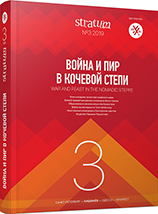Снаряжение лошади и всадника (колесничего) в восточной части скифского мира
Equipment of a Horse and Rider (Charioteer) in the Eastern Part of the Scythian World
Author(s): Petr I. Shulga, Daniil ShulgaSubject(s): History, Archaeology, Military history
Published by: Издательский дом Stratum, Университет «Высшая антропологическая школа»
Keywords: Scythian world; Scythian-like cultures; equipping of horse and rider; equipping of chariot;
Summary/Abstract: Mountainous Altai (the Republic of Altai and East Kazakhstan) and its western foothills are the only region in Eurasia where burials of horses in full harness were added to the main graves from the 8th century BC to the 19th century AD almost without interruptions. Owing to the bronze harness accessories abundance in the Mayemir culture foothill burial grounds (7th — beginning of the 6th century BC) and permafrost in the Pazyryk culture mounds (second half of the 6th — beginning of the 3rd century BC) the horse equipment of 7th—3rd cc. BC has been fully studied so far. This also allowed to trace the belt base and details evolution, which makes it possible to regard the riding harness from Altai as the standard for the Scythian world. At the same time, on its eastern outskirts in the framework of EHCC (the “eastern” historical and cultural commonality: Northern China, Mongolia, Transbaikalia, Minusinsk hollow) the equestrian equipment and its evolution had significant differences. This is partly due to the preservation of chariots using tradition during the I millennium BC. Presence of chariots in the east is marked by parts of the harness saddler and chariots details found in burial grounds, as well as the “charioteers’ buckles” transformed into “objects of unknown purpose” in the Tagar culture.
Journal: Stratum plus. Археология и культурная антропология
- Issue Year: 2019
- Issue No: 3
- Page Range: 17-35
- Page Count: 19
- Language: Russian
- Content File-PDF

